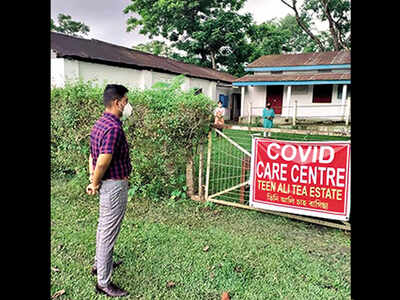- News
- City News
- guwahati News
- In upper Assam, seven districts record maximum fatalities
In upper Assam, seven districts record maximum fatalities

A Covid care centre at a tea garden in Dibrugarh
DIBRUGARH: The high Covid fatalities among tea plantation workers continue to be a cause of concern in the upper Assam tea belt with 77.14 per cent of the total deaths among the workforce coming from 7 of the 9 districts in the area.
According to official data, the state's tea gardens have reported 105 Covid deaths during the second wave of which 81 deaths have occurred in the seven districts of Dibrugarh, Tinsukia, Golaghat, Sivasagar, Charaideo, Jorhat and Lakhimpur. Only two upper Assam districts, Dhemaji and Majuli, do not have any Covid fatalities till date. Assam's 555 tea estates of the total 803 registered estates are located in the 9 upper Assam districts with Dibrugarh having the highest numbers with 177 tea gardens, followed by Tinsukia with 122 and Jorhat with 88.
In the second wave, Dibrugarh and Tinsukia districts have recorded the highest number of Covid deaths in tea gardens with both districts accounting for 26 deaths each. In Dibrugarh district, 26 deaths among tea workers have been recorded in 18 gardens. Four tea workers have died at the Greenwood estate in Dibrugarh which is the highest number of casualties recorded in a single garden in the state. Among the other tea estates in Dibrugarh district having Covid fatalities are Balijan North (2 deaths), Naharkatia (2), Korangini (2), Azizbag (2), Basmotia (2), Zaloni (1), Dikom (1), Barborooah (1), Tingkhong (1), Singlijan (1), Chubwa (1), Baughpara (1), Romai (1), Nahortoli (1), Halmari (1), Mokalbari (1) and Longboi (1). Similarly, 26 casualties have occured in 17 tea estates in Tinsukia district with Budlabeta tea estate experiencing the highest three deaths followed by Mahakali (3), Hapjan (2), Daimukhia (2), Nokhroy (2), Samdang (2), Dinjan (2), Beesakoopie (1), Hilika (1), Bazaloni (1), Hokonguri (1), Pengaree (1), Deohall (1), Betjan (1), Deamolie (1), Chandmari (1) and Rupai (1).
Among the rest of the upper Assam districts, Golaghat has 10 deaths in 9 tea estates, Charaideo has 6 deaths in 5 tea estates, Sivasagar and Jorhat have 6 deaths each in 6 tea estates each while one death has occured in a tea estate in Lakhimpur district. "Since upper Assam has the highest concentration of tea gardens, the casualties are more here. However the numbers are declining of late. One of the major reasons for the spread of the virus in the tea gardens is the congested colonies of workers. In some cases, we saw that Covid positive workers in the gardens were reluctant to shift to Covid care centres. Non-adherence to the safety protocols led to further spread of the virus in the garden areas. To control the spread among plantation workers, the tea gardens were given priority during the vaccination process," said Dr Nabajyoti Gogoi, nodal officer of Integrated Disease Surveillance Programme.
According to official data, the state's tea gardens have reported 105 Covid deaths during the second wave of which 81 deaths have occurred in the seven districts of Dibrugarh, Tinsukia, Golaghat, Sivasagar, Charaideo, Jorhat and Lakhimpur. Only two upper Assam districts, Dhemaji and Majuli, do not have any Covid fatalities till date. Assam's 555 tea estates of the total 803 registered estates are located in the 9 upper Assam districts with Dibrugarh having the highest numbers with 177 tea gardens, followed by Tinsukia with 122 and Jorhat with 88.
In the second wave, Dibrugarh and Tinsukia districts have recorded the highest number of Covid deaths in tea gardens with both districts accounting for 26 deaths each. In Dibrugarh district, 26 deaths among tea workers have been recorded in 18 gardens. Four tea workers have died at the Greenwood estate in Dibrugarh which is the highest number of casualties recorded in a single garden in the state. Among the other tea estates in Dibrugarh district having Covid fatalities are Balijan North (2 deaths), Naharkatia (2), Korangini (2), Azizbag (2), Basmotia (2), Zaloni (1), Dikom (1), Barborooah (1), Tingkhong (1), Singlijan (1), Chubwa (1), Baughpara (1), Romai (1), Nahortoli (1), Halmari (1), Mokalbari (1) and Longboi (1). Similarly, 26 casualties have occured in 17 tea estates in Tinsukia district with Budlabeta tea estate experiencing the highest three deaths followed by Mahakali (3), Hapjan (2), Daimukhia (2), Nokhroy (2), Samdang (2), Dinjan (2), Beesakoopie (1), Hilika (1), Bazaloni (1), Hokonguri (1), Pengaree (1), Deohall (1), Betjan (1), Deamolie (1), Chandmari (1) and Rupai (1).
Among the rest of the upper Assam districts, Golaghat has 10 deaths in 9 tea estates, Charaideo has 6 deaths in 5 tea estates, Sivasagar and Jorhat have 6 deaths each in 6 tea estates each while one death has occured in a tea estate in Lakhimpur district. "Since upper Assam has the highest concentration of tea gardens, the casualties are more here. However the numbers are declining of late. One of the major reasons for the spread of the virus in the tea gardens is the congested colonies of workers. In some cases, we saw that Covid positive workers in the gardens were reluctant to shift to Covid care centres. Non-adherence to the safety protocols led to further spread of the virus in the garden areas. To control the spread among plantation workers, the tea gardens were given priority during the vaccination process," said Dr Nabajyoti Gogoi, nodal officer of Integrated Disease Surveillance Programme.
FacebookTwitterLinkedinEMail
Start a Conversation
end of article
Quick Links
Delhi Air PollutionDelhi TemperatureChennai WeatherBangalore TemperatureCovid vaccination centres in DelhiCoronavirus in DelhiRTPCR test in GurgaonHyderabad RainPollution level in BangaloreDelhi SmogDelhi TemperatureNoida AQIGurgaon AQI todayFire in MumbaiMumbai RainsCovid 19 RT PCR Test in NoidaDelhi AQI todaySrinagar encounter
